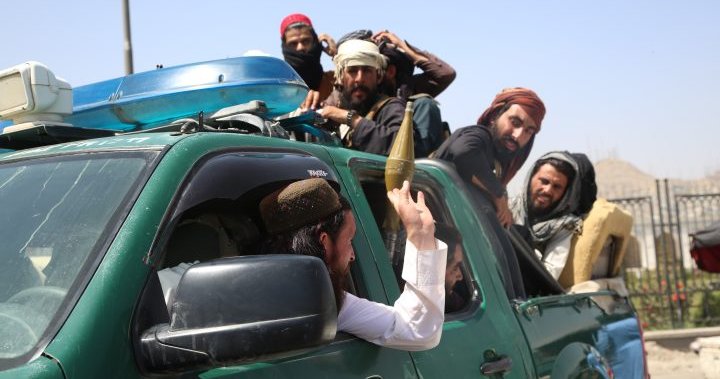What’s happening now in Afghanistan? Here’s a timeline of major events – National | Globalnews.ca
As chaos in Kabul continues amid Afghanistan‘s mass evacuations, the Taliban‘s rapid takeover and a suicide bombing that left more than 180 dead — including American soldiers — all eyes are on the U.S. now that the deadline for their final military withdrawal rapidly approaches.
Read more:
Ottawa’s Afghanistan failure is a stain on the country
The Taliban had moved with surprising speed in the months after U.S. President Joe Biden announced the withdrawal of the remaining American troops from the country. A key turning point came when a contingent of U.S. troops emptied a major base — the militant group swept through and effectively conquered the majority of Afghanistan — including its capital — within weeks.
The Islamist group’s brutal reign of the country from 1996 to 2001 included stoning adulterers and banning women from working outside their homes or attending school, until they were pushed back by U.S.-led coalition forces hunting down elements of al-Qaeda that were being sheltered.

Fears over possible reprisals on Afghans that helped coalition forces have prompted a mass exodus in recent weeks. Other Afghan civilians, including officials, journalists, activists and minority groups, have also been prompted to leave.
Here’s a look at the lead-up to the Taliban’s takeover of the country, and what’s happened in efforts to evacuate refugees so far.
Feb. 29, 2020: American and Taliban diplomats sign a peace agreement in Doha, Qatar, which saw an agreement for a U.S. withdrawal of troops and for the Taliban to stop attacks on Americans.
Later that year in September, Taliban-Afghan government talks would begin, though no progress or agreements would be made.
April 14, 2021: Biden announces the withdrawal of America’s remaining troops in Afghanistan by Sept. 11, the 20th anniversary of al-Qaeda’s terrorist attacks on the United States.
May 2021- July 2021: The Taliban start making gains across several key districts and territories across Afghanistan. Kabul remains untouched and under government control for now.
July 2, 2021: U.S. forces vacate its largest airbase in the country — Bagram Air Field — after nearly 20 years. The base is handed over to Afghan security forces, though there is some confusion with the transition.
On the same day, the Pentagon said America’s final withdrawal could be completed by the end of August — earlier than Biden’s instructions to wind down by Sept. 11.
July 8, 2021: Canadian government sources tell Reuters of plans to take in Afghan interpreters and their families amid the U.S. pullout.
Canada’s military involvement in Afghanistan has been limited for seven years, after the last active Canadian troops left in 2014.
July 14, 2021: U.S. officials unveil plans to evacuate some Afghan military helpers that assisted its troops in the region.
July 17, 2021: Canadian officials, including Immigration Minister Marco Mendicino, confirm plans to help Afghans that have worked with Canada, though they give no clear timeline or further details of the undertaking.
In the coming days, the Afghan interpreters Canada had pledged to assist say that the Immigration department is failing to resettle them and their families. Advocates decry a slow and difficult documentation process.

July 23, 2021: The federal government unveil a new “path to protection” for Afghans who supported Canadian troops in order to resettle them along with their families.
The Inbox for those Afghans to apply to resettle would later crash after the government backed off from an initial 72-hour application timeline.
July 30, 2021: The first flight bringing Afghans that helped U.S. forces arrives in Dulles, Va., carrying more than 200 people including children and babies.
Aug. 2, 2021: Afghanistan’s President Ashraf Ghani blames the rapid advance of Taliban militants on America’s speedy pullout. He said his administration would focus security forces on protecting provincial capitals and urban areas, and claimed that Afghan forces would have the “capacity” to defeat the Taliban insurgents.
Aug. 4, 2021: The first plane carrying Afghan refugees lands in Canada, though federal officials would not specify how many were on board.
In the following days, the Taliban assassinated an Afghan official, and the UN compared the impending conflict to the situation in Syria.
Aug. 10, 2021: The Taliban is estimated to have control of 65 per cent of the country, according to the European Union. Around 400,000 Afghans have been displaced from their homes.
Aug. 12, 2021: Taliban forces capture Kandahar and Herat, the country’s second and third largest cities.
Aug. 13, 2021: Canadian officials announce a program to resettle 20,000 Afghan refugees, including interpreters, activists, women leaders and members of the LGBTQ2 community.
Read more:
‘We are desperate’: The frightening new reality faced by the women of Afghanistan
Aug. 15, 2021: The Taliban begins entry of Kabul, prompting President Ghani to flee alongside a number of officials.
The insurgent group claims the Afghanistan “war is over,” with them having essentially complete control of the country following their storming of the capital.
Canada temporarily suspends diplomatic relations with the country that same day.
Aug. 16, 2021: Evacuation flights coming out of Kabul’s Hamid Karzai Airport are suspended after at least five people were killed.
Images circulate showing refugees clinging to a U.S. military aircraft as it took off, with reports of two people falling to their deaths.
Aug. 17, 2021: Evacuation flights resume out of Kabul, with U.S. forces taking charge of the airport. The Taliban maintain control of all other ground routes in the city.
In an apparent act of moderation, the Taliban declared “amnesty” for all those across the country and asked women to join their government.
Read more:
‘We want peace’: Afghans in Kabul face uncertainty as Taliban tighten grip
Two more flights arrive in Canada carrying Afghan refugees and diplomatic staff. Trudeau reiterates that Canada had “no plans” to officially recognize the Taliban as the country’s government.
Aug. 18, 2021: Biden pledges to evacuate all American citizens from the country, and said that U.S. soldiers would stay until they had all left.
Canada reaches a deal for two military planes to resume flying regularly to evacuate people from Kabul’s airport.
The Taliban would kill at least one person and injure six more after quashing a protest in Jalalabad, near the border of Pakistan.
Aug. 20, 2021: Reports of targeted killings in Taliban-controlled areas fuel the exodus of thousands more refugees to Kabul’s airport.
Biden reassures Americans still in Kabul that the U.S. would get them home, while Canadian officials begin to waive passport and COVID-19 testing requirements for Afghan refugees.
Aug. 23, 2021: U.K. Prime Minister Boris Johnson says he will convene the G7 for emergency talks on Afghanistan.
Biden also confirms that he would not rule out extending the Aug. 31 deadline set prior to the Taliban’s takeover.
Several Canadian, U.S. and other foreign agencies said they were purging content from their websites in order to protect Afghans.
Aug. 24, 2021: Trudeau announces that Canada would be “ready to stay” past the Aug. 31 deadline, set by the U.S. However, Biden would later double-down on the end-of-month evacuation date.
The U.N. reports evidence of violations committed by the Taliban, including “summary executions” of civilians and Afghan forces who had surrendered.
Aug. 25, 2021: Poland and Belgium end their Afghanistan evacuations.
Aug. 26, 2021: Reports emerge of two blasts near the entrance of Kabul’s airport.
Officials would later reveal that the explosions had killed 12 members of the U.S. military and injured another 15 — the first troops to be killed in action there in 18 months.
At least 60 Afghan civilians were reported killed and another 140 injured by end of the day.
There were no reports of Canadians being harmed, according to Global Affairs Canada.

U.S. military officials placed the blame on ISIS Khorosan, otherwise known as ISIS-K — an offshoot of the Islamic State operating in Afghanistan. The group would later claim responsibility for the suicide bombing.
In a briefing, Biden pledged to hunt down those responsible.
Canadian officials also officially ended the country’s evacuation efforts, despite some Canadians still being stuck in the Taliban-run country.
Roughly 3,700 people were evacuated during the operation, according to Gen. Wayne Eyre.
Aug. 27, 2021: The death toll from the blast rises to more than 180 people — 169 Afghans and 13 U.S. service members in total, according to officials.
Canadian officials also said they had secured 500 seats on a U.S. flight from Kabul to pull out citizens and refugees it had left behind.
The U.S. military said it had used a drone strike to kill a member of the Islamic State’s affiliate group believed to be behind the bombing.
—With files from Reuters, the Associated Press and The Canadian Press
© 2021 Global News, a division of Corus Entertainment Inc.
For all the latest world News Click Here




